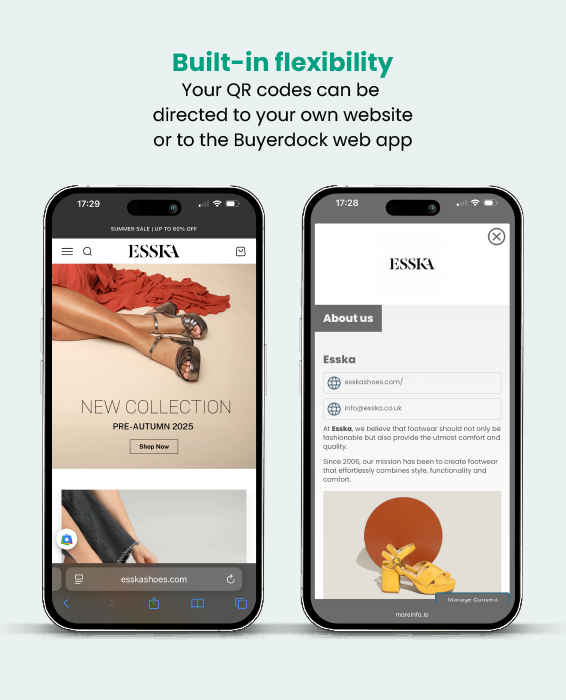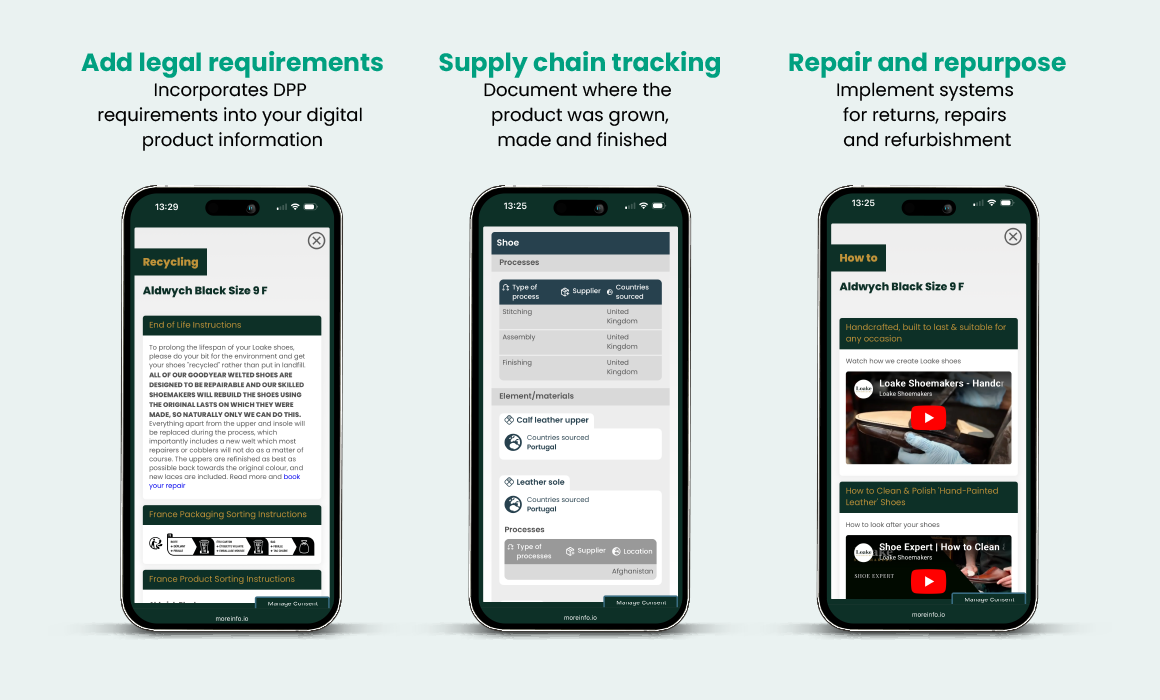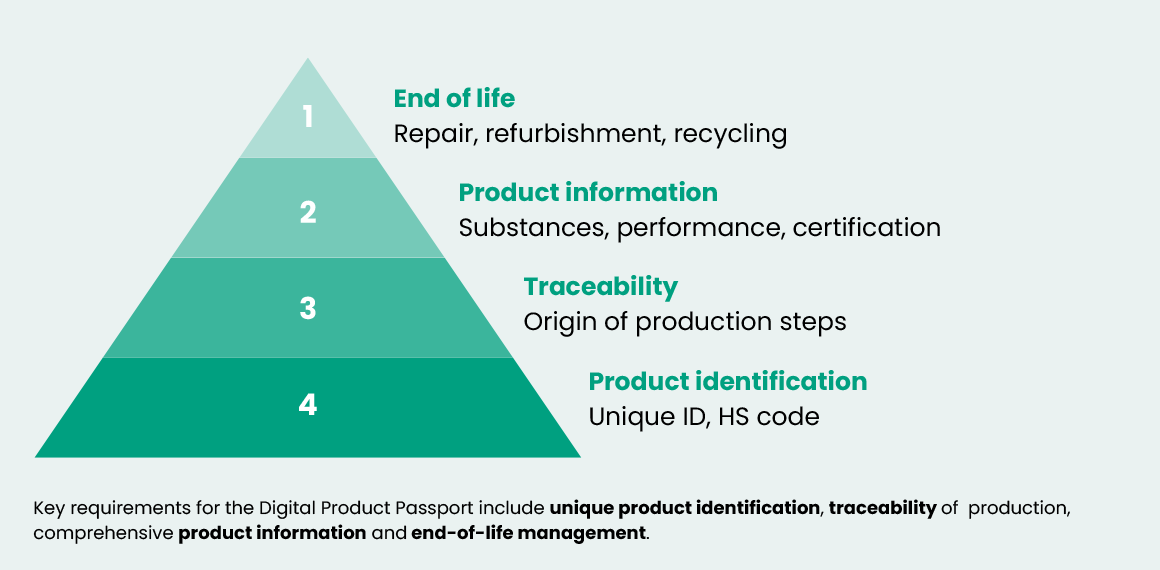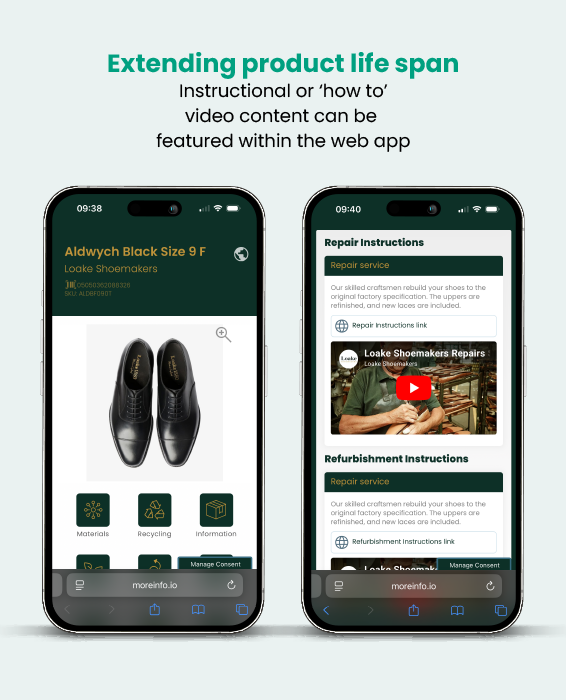

We know that creating Digital Product Passports can seem complex, especially with evolving regulations. That’s why we’ve simplified the process into clear, manageable stages.
By completing Step 1, you’re already well on your way. This early foundation gives you the time and structure to build your DPPs at a steady pace — without disruption or last minute panic.
Your progress now means fewer challenges later.
Content rich app

Start with your barcodes
Getting started is simple. Upload your existing barcode numbers to Buyerdock, and within minutes, your iQRcodes™ will be automatically generated using GS1 Digital Link technology.
You can then apply these iQRcodes™ to your product packaging. While adding the iQRcode™ is just the first step, it lays the foundation for easy access to global compliance moving forward. It creates a single, smart access point where you can continue to build and update your product data as requirements evolve.
Adding the iQRcode alone doesn’t make you instantly DPP compliant — but it puts the right system in place to get there.
This step is important. Adding iQRcodes™ later can be complex and costly, especially once packaging is finalised. By acting now, you lay the foundation for long-term compliance without disruption.
Finally, point your iQRcodes™ to your website or product pages.
Select your destination

An additional and optional part of this step is capturing the batch and serial numbers on the product level:
Add batch and serial numbers to make each product unique. This allows for differentiation in production locations and supply chain information. Ensuring that individual product’s supply chain is captured.
Use the format: moreinfo.io/01/[barcode]/10/[batch]/21/[serial]. This structure allows for that unique supply chain data to be captured.
If shirt A is made in India: moreinfo.io/01/05033400000023/10/123/21/abc123
Or if that same shirt A is made in China: moreinfo.io/01/05033400000023/10/124/21/abs123
If this step seems challenging now, you can implement batch/serial numbers on your second print run, allowing for a phased approach.
The following is the minimal data required to create an iQRcode™ on Buyerdock:
We recommend building the first product manually on Buyerdock as this will then unlock our data spreadsheet which can simply be copied and pasted for multiple products upload.
Start now FAQsQ. Is an iQRcode™ the same as a normal QR code?
A. Not exactly. An iQRcode™ may look like a regular QR code, but it’s built differently. It’s a dynamic, data-driven code that’s linked directly to your product’s unique GS1 barcode. That means it’s always connected to your product’s identity, no matter where or how it’s scanned. Unlike a standard QR code, which sends everyone to the same static webpage, an iQRcode™ delivers up-to-date, tailored information based on location, language, product type, or local regulations. It’s a smarter, more flexible way to communicate with consumers — and stay compliant across markets.
Q. I already have a QR code on my products, what happens to this one? How are they different?
A. Your existing QR code probably links to a fixed webpage or campaign. An iQRcode™ is different. It’s built on your product’s unique GS1 barcode and connects to dynamic, updatable data. You can easily make the switch by entering your Product Name, SKU, GTIN, and the URL you currently use into the Buyerdock platform. Then, download your new iQRcode™ and use it in your next print run. This future-proofs your packaging. Your iQRcode™ becomes the single point of access for all product information — ready to grow with you as new requirements come in. You don’t have to do everything at once. By setting the foundation now, you can stay compliant at your own pace, adding more data only when it becomes necessary or available. It’s a simple step that prepares you for upcoming Digital Product Passport requirements and other regulations, both in the UK and globally.
Q. What downloadable iQRcode™ file formats are available?
A. You can download your iQRcode™ in both PNG and SVG formats. PNG is ideal for quick use in digital and print materials. SVG is a high-quality, scalable format, perfect for packaging and professional design work.
Q. Will iQRcode™ replace linear barcodes on my product packaging?
A. Not immediately, but change is coming. The traditional EAN/UPC (1D) barcode has served the retail world for decades, mainly for price lookups. But it can’t support the growing need for detailed product information, traceability, or authentication. That’s why the global supply chain is now preparing to transition to 2D barcodes like the iQRcode™, which can carry much more data in a single scan. The industry has set a goal to accept 2D barcodes at point of sale by Sunrise 2027. Preparing now by adopting iQRcodes™ means you’ll be ready for this shift — without needing to rush later.
Q. Our packaging is tight for space, can I take all my current information and put it behind the new iQRcode™?
A. The iQRcode™ can reduce how much you need to print on-pack, but some information still needs to remain visible, depending on local regulations. Many countries require certain details such as ingredient lists, allergen warnings, safety instructions, or recycling symbols to be printed directly on the packaging. These requirements vary by product category and region. What the iQRcode™ does allow is the ability to move additional or extended content into a digital format. This could include traceability data, sustainability claims, certifications, marketing promotions, repair schemes, or deeper regulatory information. It’s a smart balance: print what’s required, digitise what you can. You free up space on-pack while keeping your product information accessible, up to date, and future-ready.
Q. Who owns the iQRcode™? What happens if we at a later date want to move away from Buyerdock?
A. You do. The iQRcode™ is linked to your product’s unique digital identity, and it remains yours even if you leave the Buyerdock platform. If you decide to move on, you can download all of your data and close your account. You’ll need to update the QR code’s destination URL to point somewhere else — so when someone scans your product, it still leads to the information you want to show. However, the dynamic features of the iQRcode™ (like location-based content or automatic updates) will no longer function unless you replicate that capability elsewhere. In short: the code is yours, the data is yours, and you’re free to take it with you. Buyerdock simply helps you manage and deliver it in a seamless fashion.
Q. Can my iQRcode™ be compromised?
A. Any QR code can be compromised if mismanaged. But when using a GS1 Digital Link through the Buyerdock secure iQRcode™ platform, which includes access control, encryption, and scan monitoring, the risk is minimal. GS1 compliance ensures global trust, traceability, and protection against misuse.
Q. Can I track clicks on my iQRcodes™?
A. Yes, Buyerdock includes built-in analytics. You’ll see daily updated data showing total views, unique users, and which product sections are viewed most (like About Us or Traceability). You can also filter by day, week or month and get basic user demographics. This helps you understand how your iQRcode™ content is performing and what your customers are most interested in.
Q. What if I don’t have a GS1 barcode?
A. That’s okay. While we recommend using a GS1 barcode — because it’s globally recognised and forms the foundation for most product identification — we understand that some businesses use their own internal systems. We’re here to help. If you don’t currently use GS1, we can work with you to find a suitable workaround that still allows your product information to be delivered effectively and in line with compliance needs. Just get in touch with our team. We’ll guide you through the best solution for your setup and help you prepare for future requirements.
Q. Are all the fields listed mandatory?
A. Only a few key fields are required to get started. To generate your iQRcode™, you’ll need to provide: Product name, product description, category, barcode number, brand, sku, GTIN and url to product. All other fields are optional and can be added later. This allows you to build at your own pace while ensuring you’re set up correctly from the start.
Q. Does this step generate my recycling logos?
A. Not quite, but you’re almost there. Adding your product data gives you access to the Eco Recycling Logos tool, which helps manage country-specific recycling rules—starting with France. You’ll be able to input sorting info, check display criteria, and prepare for regulations like the AGEC Decree. Once the details are complete, you can generate and download compliant recycling logos tailored to each market.
Q. If I don’t sell directly to the EU but use Amazon or Shopify, do I still need to comply with recycling regulations?
A. Yes, if your products are shipped to countries like France, Italy, Spain or Portugal you’re still responsible for meeting local recycling label laws — regardless of whether you sell through Amazon, Shopify, or your own website. If you’re an Amazon seller shipping to France or Italy, whether Fulfilled by Amazon (FBA) or Fulfilled by Merchant (FBM), your packaging must include the correct recycling logos. Failure to do so could result in significant penalties. In France, non-compliance can lead to fines of up to €100,000 or even criminal liability under the AGEC law. The same applies if you sell directly to consumers through platforms like Shopify or WooCommerce, or if your products are sold in any physical retail space in France or Italy. These rules have been in place since 2022, and all stock must now carry the appropriate recycling information. Buyerdock’s tools help ensure you meet these country-specific requirements—clearly, correctly, and without guesswork.
Q. Does Step 1 make my product fully compliant with current DPP regulations?
A. Not fully, but it sets you up with the core foundations — and that’s exactly what you need right now. The required elements of a Digital Product Passport (DPP) are still being finalised under the EU’s Ecodesign for Sustainable Products Regulation (ESPR). Full enforcement is expected to begin from 2026, starting with select product categories such as batteries, textiles, and electronics, and expanding from there. At present, no product categories are fully required to comply, though some, like toys, do already require technical documentation that overlaps with future DPP expectations. Step 1 on Buyerdock allows you to capture the core data structure aligned with GS1 Digital Link standards. This includes product identity, traceability, and dynamic access to information — giving you a future-ready setup that can be built on over time. By starting now, you avoid the cost and disruption of retrofitting later and position your business to adapt smoothly as DPP regulations become mandatory.
Q. What if I don’t have all of the minimum data required?
A. That’s not a problem. Just get in touch with us. We can take a look at the data you do have and advise you on the best next steps. In many cases, we can help you move forward with what’s available and guide you on how to fill any gaps over time. Our goal is to make the process as simple and manageable as possible, no matter where you’re starting from.
Q. Can I import data by Excel or API?
A. You can import data by Excel, CSV files on our Enterprise plan. We’ve just launched our new Excel upload tool, currently in beta. To get started, simply contact us here, and a member of our team will arrange a quick call or Zoom session. While we’re in beta, we’ll handle the uploads for you at no charge. Selling on Amazon Seller Central? That makes things even easier. You can export a Category Listings Report and copy the relevant fields into our template. In testing, we created over 1,000 listings in under 10 minutes. We’re here to help make setup as simple and smooth as possible. API access isn’t included as standard, but we’re happy to explore the best solution for your business as part of an Enterprise plan.
Q. Can I have multiple brands on one account?
A. You can add as many brands under your company as you want by going to the brands page accessed from the left menu. Please note, you need to select the associated brand and attach it to the product under the General information tab on Edit Product pages. NB: The About us tile on the app always shows the overall company name and detail. Bear this in mind if you are building products for multiple brands and companies, it is best practice to have the owner/director set up the company account and then add users to manage it for them.
Q. Can I have multiple users on one account?
A. Yes, you can easily add multiple users to your Buyerdock account. Just go to Manage Users in your account settings to get started. You can assign different levels of access depending on each team member’s role: Admin(s): Can manage company details, brands, and products. They can also add or remove users but do not have access to billing information. Manager(s): Invited by the Owner or an Admin. They can manage products but cannot view or manage other users. Member(s): Also invited by the Owner or an Admin. They can view products, brands, and analytics, but cannot make changes. This setup gives you flexibility to collaborate while keeping control over who can do what. If you need help setting it up, just reach out — we’re happy to assist.
Q. Can step 1 help my business comply with GPSR?
A. While Step 1 alone does not create full GPSR compliance, it allows brands to display responsible person details digitally via the iQRcode™, making it easier to meet the GPSR requirement for visibility—especially for sellers managing large product ranges or multi-market distribution. You can then update this information across all products at once, without reprinting packaging. For more assistance with GPSR we recommend checking our Partners Page specifically Expandly.
Create and test experiences
Build tailored customer journeys by linking your iQRcode™ to relevant content—promotions, sustainability messaging, instructions, or brand stories.
Collect valuable data
Track how and where your iQRcodes™ are being scanned. Start learning who your customers are and what content resonates most.
Optimise and improve
Use engagement data to refine your messaging, improve customer experience, and increase the impact of your campaigns over time.
Think of DPPs not just as a regulatory hurdle, but as a tool to unlock real value. According to Bain & Company and eBay, DPPs have the potential to double a product’s lifetime value by enabling resale, authentication, aftercare, and new services — long after the first sale.
Marketing and testing

We recommend adding as much of the following data points to give your customer the best experience and knowledge about you and your products. This is in addition the basic requirements in step 1. This can be completed while your product is being created and can be a phased approach once the product is on sale. The app will already function as a basic app with step 1 (although we recommend the very minimum adding of image and description).
None of these features alone will make your product compliant with Digital Product Passport (DPP) regulations. The only sections that are currently mandatory are the on-pack recycling logo, which is now legally required in France, Italy, Spain, and Portugal. Spain requires clear pictograms showing the correct recycling bin, while Portugal mandates disposal instructions in Portuguese, using either text or symbols and also GPSR. These rules are already in effect, and more EU countries are expected to introduce similar requirements. Ensuring this information is in place keeps your packaging compliant across key European markets.
The rest of the information elements below are purely functional for the enhancement of the consumer app. You can choose whether to add links, videos or just text on some of the options.
Brands that design their DPPs with consumers in mind can build trust, track ownership, and open new revenue streams, rather than just meeting compliance.
Timeline for DPP compliance

Q. Can I customise the look and feel of my web app?
A. Yes, if you’re on our Enterprise plan. We can fully customise your web app to reflect your brand. This includes creating as many tiles as needed to suit your business — whether that’s for sustainability content, brand storytelling, how-to guides, or regulatory information. If you’d like to upgrade or explore what’s possible, just get in touch. We’ll work with you to create an experience that takes your app to the next level of consumer engagement.
Q. Are there any limits or restrictions on upload size for documents, videos & images?
A. Yes, there are a few guidelines to keep in mind: Documents (e.g. technical files, safety data): Maximum file size is 4 MB. Accreditations: Uploads must be in JPG or PDF format, ideally around 800 × 800 pixels, and no larger than 4 MB. Videos: Cannot be uploaded directly, but you can embed video links from platforms like YouTube or Vimeo. If you’re on the Enterprise package, we can also include a custom landing/splash page that features video content pulled directly from your Instagram or TikTok channels. This is particularly effective in the lead-up to seasonal campaigns or product launches, giving your customers a more engaging and branded experience. If you have any questions or need support, our team is here to help.
Q. If I upload documents, will they be translatable like the rest of the app?
A. No, uploaded documents are not automatically translated. We recommend uploading your documents in the languages of your key markets. While the app interface and content tiles can be translated, any PDFs or other files you upload will display exactly as they are. To ensure a consistent experience across regions, consider providing translated versions of important documents like safety sheets, certifications, or product guides.
Q. Can I link to certificates and documents hosted on my own website or 3rd party websites?
A. Absolutely, you have the option to link and/or upload certificates and documents straight to the platform.
The required elements of a Digital Product Passport (DPP) are still being finalised under the EU’s Ecodesign for Sustainable Products Regulation (ESPR). Full enforcement is expected to begin from 2026, starting with select product categories such as batteries, textiles, and electronics, and expanding from there.
Completing DPP Requirements

The Digital Product Passport will require the following elements, our recommendation is to add this information as and when as it is available to you, it doesn’t need adding all at once. The app will automatically display the data as you update each element.
Key DPP requirements

Supply chain transparency is a key part of creating a fully functional digital product passport, which will be critical in 2027 for consumers and businesses looking to track product authenticity and environmental impact.
Repair and repurpose features

Q. Which fields do I need to populate to have a Digital product passport?
A. To create a Digital Product Passport (DPP), you’ll need to include key information across four areas: unique product identification (such as a GTIN, SKU or serial number), traceability of production (including supplier details, country of origin, and materials used), comprehensive product information (like technical specs, compliance documents, and sustainability data), and end-of-life management (such as recycling instructions, repair guides or disposal methods). Buyerdock allows you to build this step by step—starting with the essentials and adding more as your data becomes available.
Q. How secure is my data?
A. Very secure—and we take it seriously. We protect your data using the same level of security trusted by major online platforms. Access is protected by strong passwords and two-factor authentication (2FA), meaning even if someone guesses your password, they still can’t get in without a second verification step. Behind the scenes, we have real-time monitoring to detect suspicious activity, and safeguards in place to stop things like brute force login attempts, DDoS attacks, or unauthorised access. Your data is also encrypted, backed up daily using secure, off-site storage, and access is limited only to authorised team members who need it for legitimate reasons. We never share your data with unknown third parties, and all access happens over encrypted connections. In short, your data is protected on every level—from login security to server infrastructure. If you ever have concerns, our team is always here to answer questions.
Q. Can you recommend companies to help me fulfil my Supply chain requirements?
A. Absolutely. We work with trusted partners who specialise in supply chain transparency, traceability, and compliance. Head over to our Partners Page to explore who we recommend and how they can support your business.
Q. Will you advise what data I need to import in relation to my product type (garments, food, machinery etc.)
A. Absolutely. When you first add a product, Buyerdock will ask you to select a product category. Based on your selection, the platform will automatically unlock the relevant fields and data sections specific to your product type. For example, a garment will prompt fields like material origin, certifications, and end-of-life instructions, while food products will unlock allergen and ingredient sections. Machinery may focus more on safety documents, compliance certifications, and traceability data. This tailored approach ensures you’re only asked for what’s relevant to your product—making the onboarding process simpler, clearer, and more efficient.
Q. How will I be alerted to compliance and regulation updates?
A. Your dashboard shows links to the latest updates. We keep your dashboard up to date with links to relevant blog posts, news, and announcements. You’ll also have access to webinars and sessions run in partnership with organisations like AVASK, GS1, the UK Export Academy, and the UK Department for Business and Trade. Think of the Buyerdock platform as the board — and regulations as the puzzle pieces. As each new piece becomes available, we help you slot it in clearly and simply. While we don’t offer legal advice, we make it easy to display your compliance information in one place, so you’re always building toward a complete, up-to-date picture.
Q. Do you offer product tracking?
A. Yes, through our trusted partners. While we don’t try to be a one-stop shop for everything, we work with experienced product tracking specialists who do it exceptionally well. Through these partners, we can stream live tracking data directly into your Buyerdock web app — giving you seamless visibility without compromising on quality or reliability.
Q. How can you prove product authenticity?
A. Each iQRcode™ generated by Buyerdock is uniquely tied to your product and verified through the GS1 database. This means every code is checked for authenticity and linked to the correct manufacturer — making it extremely difficult for counterfeit products or fake QR codes (also known as “quishing”) to slip through. Because each iQRcode™ is backed by an immutable record, it adds a strong layer of trust and traceability across your supply chain.
We are always available to support you and help you achieve product
compliance. If you need assistance please arrange a FREE consultation
with one of our support team.